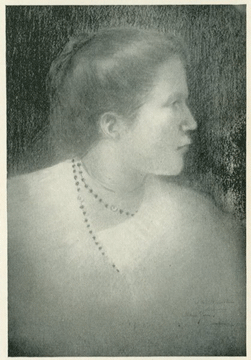Studies from an eastern home
 |
The holy city |
|
THERE is a picture lately purchased by the committee of the Calcutta Art Gallery, which for those who know anything of the art of Mediæval Italy is full of significance. Throughout the growth of the Mediterranean civilisations the student is constantly impressed by the vigour of the civic rather than the national ideal. We think clearly and continuously--not of Egypt, Judæa, Syria, Greece, Italy, Spain and Africa--but of Memphis, Thebes, Jerusalem, Tyre, Damascus, Ephesus, Athens, Rome, Carthage, and it may be a score or two of others. The state appears in our minds as merely a vague hinterlandlike appanage of the city thus conceived. Nor can we fail to see the influence which the pursuit of civic ideals has had upon the religious conceptions both of Judaism and of the Christianity which succeeds it. It strikes upon an Indian ear as somewhat strange that the Jew should be able, in such good faith, to denote so much as he does simply by the use of the name of a municipality. "Send thee help from the sanctuary and strengthen thee out of Zion." We should find it difficult to say; "Send thee help from the sanctuary, and strengthen thee out of--Indraprastha," for instance. And yet why? But so deep was the habit of thought with the Jew that he has been able, through his incomparable literature, to stamp with a like vividness the names of many cities even outside Palestine proper, so that Babylon, Nineveh, and Damascus call up to this day certain larger than civic attributes which he, more or less justly, associated with them. It was natural enough, then, that a Judaic apostle should delineate Heaven as the New Jerusalem, that beloved city of his race. And it was in accordance with the ancestry of the Faith that the dreamers of the European Middle Ages should constantly present us with a Paradise that resembles a city or township much more closely than a country or a fatherland. Even Dante and Giotto, in spite of the enormous grasp of their minds, were both civic dreamers, and it seemed natural to them that Beatrice should shine as fair in Heaven as she shone in Florence. The cursory reader might regard it as a foregone conclusion that such civic passion as this was never known in India. For even Benares--which resembles Jerusalem in being a sacred city of no less than three religions--even Benares is more strictly national than civic in its character. Every state in India had built a palace within the sacred area. Every religion possesses there a cathedral, and its charities from the municipal point of view are apt to fail. Colleges of Sanskrit learning, almonries of daily doles for pilgrims and poor students; monasteries filled with devotees--all these do not suffice for the needs of the city from that purely territorial point of view which is the civic spirit proper, and the evolution of charities having this aim has been left for modern times. And yet, there have in all ages been great and resonant names in India that should give us pause ere we venture to arrive at the sweeping conclusion that civic passion is foreign to the Indian spirit. What about Chitore, that rock-built crown of the Rajput deserts? What about Delhi, Amritsar, Poona, Conjeeveram, and a hundred others? Yes, and one more, one which stands revealed in this picture newly brought to Calcutta--what about Ayodhya? It is a small picture, measuring not many inches either way. The colours are rich and mellow, in the old missal-like style of Indian painting, The foreground is filled with a scarf-like band of figures, painted for the most part in ginger-shades of orange and yellow. Behind riset he white marble walls and towers of Ayodhya, and beyond only a narrow strip of sky is seen above the horizon. To those familiar with the Madonna and Child of Italian painters the figures in the front are easy to understand. Under the umbrella of state--which, by the way, is decorated with real pearls, and suggests the baldachino of Roman churches--sit Sita and Rama on a double throne. In Rama's hand is an exquisitely decorative white lotus, reminiscent of the Annunciation lily of the angelic messenger. On the right of the king stand his brothers, on the left of the queen her ladies of honour, and Hanuman kneels at the feet of the royal pair. The scene is laid in the gardens of Ayodhya. In the moat behind, bathers and a couple of elephants are seen, swimming and sporting in the water, and the royal barge is shown in all its glory. But it is on the snow-white buildings of Ayodhya that stretch from beyond the moat into the blue that the artist has spent all his powers. Intending perhaps to delineate a palace, he has actually given us a city, filled with life and motion and happiness. But it is the city of Paradise. No human scene, alas, was ever poised so dream-like between earth and heaven. No human scene was ever so perfect, growing more and more distinct as we examine it closer and in greater detail.
|
- www.vivekananda.net edited by Frank Parlato Jr.